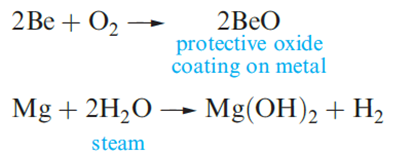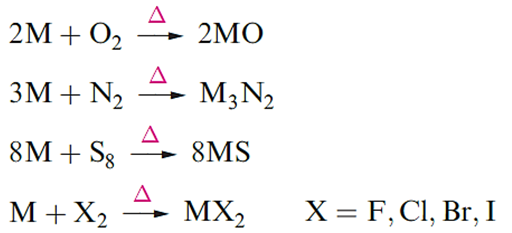
Reactivity of the group 2 metals
 المؤلف:
CATHERINE E. HOUSECROFT AND ALAN G. SHARPE
المؤلف:
CATHERINE E. HOUSECROFT AND ALAN G. SHARPE
 المصدر:
Inorganic Chemistry
المصدر:
Inorganic Chemistry
 الجزء والصفحة:
p 279
الجزء والصفحة:
p 279
 17-1-2018
17-1-2018
 2139
2139
Reactivity of the group 2 metals
Beryllium and magnesium are passivated and are kinetically inert to O2 and H2O at ambient temperatures. However, Mg amalgam liberates H2 from water, since no coating of oxide forms on its surface; Mg metal reacts with steam or hot water.

Beryllium and magnesium dissolve readily in non-oxidizing acids; magnesium is attacked by nitric acid, whereas beryllium reacts with dilute HNO3 but is passivated by concentrated nitric acid. Magnesium does not react with aqueous alkali, whereas Be forms an amphoteric hydroxide.
The metals Ca, Sr and Ba exhibit similar chemical behaviours, generally resembling, but being slightly less reactive than, Na. They react with water and acids liberating H2, and the similarity with Na extends to dissolution in liquid NH3 to give blue solutions containing solvated electrons. From these solutions, it is possible to isolate hexaammines, [M(NH3)6] (M = Ca, Sr, Ba), but these slowly decompose to amides .

When heated, all the group 2 metals combine with O2, N2, sulfur or halogens.

Differences between the first and later members of group 2 are illustrated by the formation of hydrides and carbides. When heated with H2, Ca, Sr and Ba form saline hydrides, MH2, but Mg reacts only under high pressure. In contrast, BeH2 is prepared from beryllium alkyls. Beryllium combines with carbon at high temperatures to give Be2C which possesses an antifluorite lattice. The other group 2 metals form carbides MC2 which contain the [C≡C]2- ion, and adopt NaCl lattices that are elongated along one axis. Whereas Be2C reacts with water the carbides of the later metals hydrolyse to yield C2H2. CaH2 is used as a drying agent but its reaction with water is highly exothermic.

The carbide Mg2C3 (which contains the linear [C3]4- ion isoelectronic with CO2) is formed by heating MgC2, or by reaction of Mg dust with pentane vapour at 950 K. Reaction of Mg2C3 with water produces MeC≡CH.

 الاكثر قراءة في مواضيع عامة في الكيمياء اللاعضوية
الاكثر قراءة في مواضيع عامة في الكيمياء اللاعضوية
 اخر الاخبار
اخر الاخبار
اخبار العتبة العباسية المقدسة


